
How crisis over Kuril Islands helps Kyiv in war with Russia
The lingering territorial dispute between Moscow and Tokyo over the Southern Kuril Islands benefits Ukraine by securing support from Japan, poised to sign a multi-year security agreement
The Kuril Islands are an archipelago of 56 volcanic islands of various shapes and sizes that stretch over a distance of 1300 km from the north of Japan to the southern tip of Russia's Kamchatka. The total area of all these islands is about 10.5 thousand square kilometers. Only 20 thousand people live on this entire territory.
The Kuril archipelago is of strategic importance because it is the gateway to Okhotsk Sea, from where the Russian Federation conducts its policy in the Pacific region.
The most interesting thing is that it was because of the Kuril Islands that World War II officially did not end! After all, neither the Soviet Union nor Russia signed a formal separate peace treaty with Japan, because the latter did not recognize their claims to the southern Kuril Islands (Northern Territories of Japan), which were captured by the USSR during the war and transferred to Russia.
Espreso tells the story of the Kuril Islands, when and to whom they belonged, whether a war could break out there, and how this dispute helps Kyiv.
What the article is about:
- Kuril Islands' settlement history;
- The background of the confrontation over the Kuril Islands between Japan and Russia;
- Why the dispute over Japan's Northern Territories is in Ukraine's favor.
Kuril Islands' settlement history
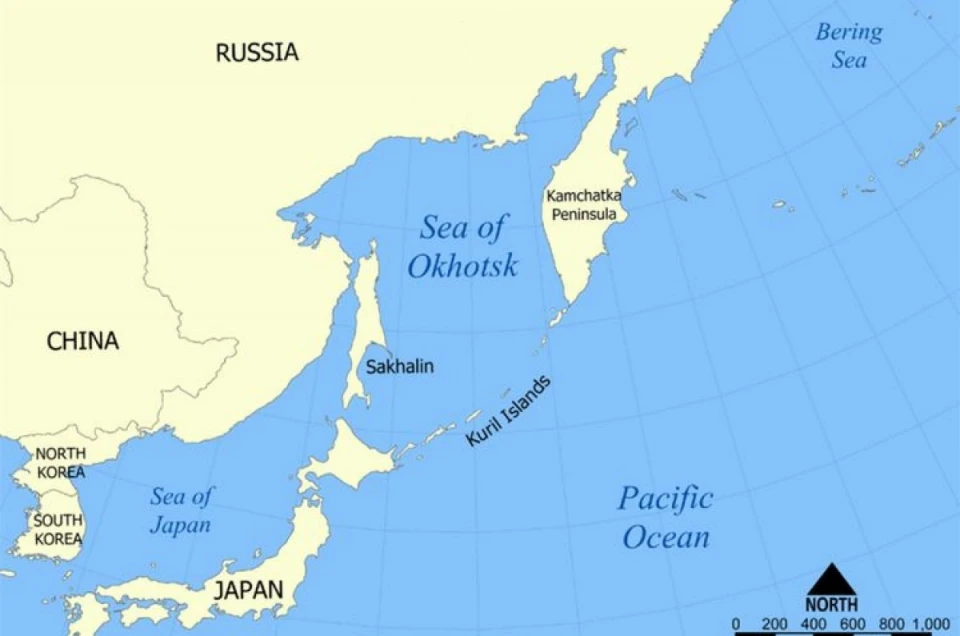
Photo: Wikipedia
Many people believe that all of present-day Japan has always been inhabited by the Japanese. However, the history of these islands is much more complicated. In fact, the southern island of Hokkaido, which looks like a dragon's head on a map of Japan, was hardly Japanese until the fifteenth century. Although representatives of various cultures and tribes lived on this island for several thousand years, since the eighth century these territories have been inhabited by the Ainu people (or, as the Japanese say, the Enzo).
In fact, the Ainu spread over vast territories-from the south of Sakhalin, Hokkaido, and all the Kuril Islands, and even to the very tip of Kamchatka. By the way, the origin of the Ainu is still a mystery to archaeologists, although it is most likely that they are of Mongoloid genesis and formed into a separate demos hundreds of thousands of years ago.
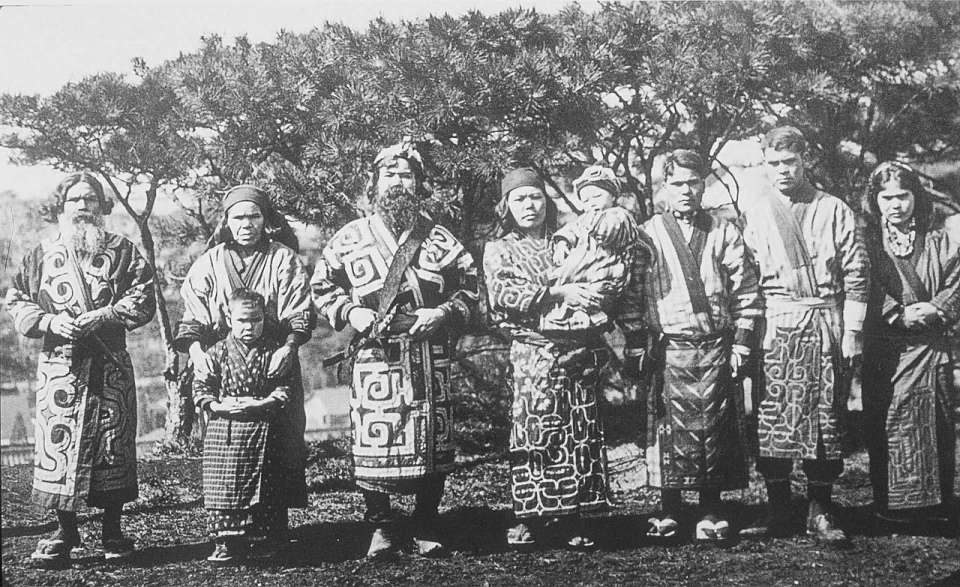
Photo: Wikipedia
That is, the native population of the Kuriles is considered to be the Ainu, who have lived there for about 1,500 years. We owe the name Kuril Islands to the Ainu, because that's how they called themselves - Kurilians (translated as people). However, it should be emphasized that the Ainu have never been numerous on the Kuril Islands. In general, these islands have always been almost uninhabited throughout history due to their remoteness, frequent natural disasters, and limited resources for life.
Today, about 200,000 Ainu live in Japan, but most of them have assimilated with the Japanese due to the country's long standing aggressive policy, so only about 20,000 of them truly consider themselves a separate people. On the present-day Kuril Islands, the Ainu have also survived, but they are few in number. On the one hand, the Japanese began to displace the Ainu through forced assimilation, and on the other hand, during the Russian Empire and later the USSR, many different cultures were brought to the Kuriles, including Russians, Ukrainians, Belarusians, Eskimos, Tatars, and others. An interesting fact is that the largest Kuril island of 7,000 people, Iturup, is 60% populated by ethnic Ukrainians!
So, back to history. During the fifteenth and sixteenth centuries, Japanese clans, overcoming the resistance and uprisings of the Ainu, were able to advance across Hokkaido and in the seventeenth century to think about the Kuril Islands, meaning that real colonization began during the Edo shogunate. Maps of the mid-sixteenth century show almost 40 islands that were nominally part of the Japanese state. Why nominally, because the Japanese did not care about all the islands and did not have enough people to settle them.
Then foreign powers intervened. In particular, the Dutch began to sail the islands, looking for opportunities for profitable trade. In addition, in the second half of the seventeenth century, the Muscovites began to take an interest in the islands, but the first Russians entered the Kuril Islands in 1711, when a detachment of Cossacks from Kamchatka sailed to the nearest island, Shumshu. This was the beginning of the Russian advance, which at first was very limited, but by the end of the seventeenth century had gained momentum.
Of course, Russian maps depicted these islands as part of their empire, but in fact, most of the islands were no one's. The Russian-American Company, a well-known private company in history, operated there on behalf of the Russian emperor and was engaged in trade, management, colony development, etc. (in particular, this company managed Alaska).
The background of the confrontation over the Kuril Islands between Japan and Russia
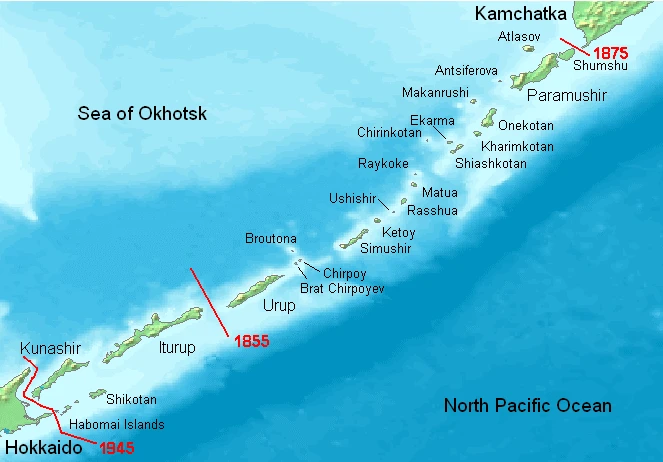
Photo: Wikipedia
From the end of the seventeenth century, the Kuriles first became a place of struggle between the Russians and the Japanese. The Japanese did not want the Russians to be too close, while the Russians, on the contrary, wanted more and more territorial conquests (as they do now). At the beginning of the nineteenth century, sporadic military clashes for dominance on the archipelago began to occur. At that time, small islands changed hands. By the middle of the century, the situation calmed down and Russia's sphere of influence included the islands north of the Frieza Strait (Shumshu-Urup), and Japan's sphere of influence included the islands south of this strait (Iturup, Kunashir, Shikotan, and the Habomai sub archipelago).
During the Crimean War, the Russians and the Japanese signed the first diplomatic agreement, the Treaty of Simod (1855), which established “peace and friendship” between the two countries and for the first time confirmed the border lines that had developed between the Russians and the Japanese. However, with the amendment that the Russian Empire also received the island of Urup. By the end of the century, however, the situation had changed dramatically in favor of Japan.
Since the Japanese imperial house regained full power over the country in 1867 (the popular movie Samurai with Tom Cruise tells the story), the expansion of the Japanese empire began, which included the expansion of land for Japanese residence. In addition, when the Russian-American Company, which managed the Kuriles, was liquidated after the sale of Alaska to the Americans, the Russian Kuriles were essentially abandoned to their fate.
In 1875, the Russians agreed to give up all of the Kuril Islands in exchange for the Japanese recognizing all of Sakhalin as Russian territory. Thus, by the end of the nineteenth century, the entire Kuril archipelago was part of the Japanese Empire. The Japanese began to actively impose their policy and turn the Kuriles, so to speak, into “truly Japanese lands.”
It was a difficult period for the Kurilian Ainu, as they were subjected to various forms of harassment, resettlement, and lost both their land and their culture. The nature of the islands also suffered at this time, as the empire pursued a predatory policy towards all resources, including the destruction of many animals, fish, and forests.
The beginning of the twentieth century was again not in favor of the Russian Empire, as the Russo-Japanese War of 1904-1905 showed that the young Eastern Empire, despite its many times smaller size, was significantly superior to the Russians. After the defeat, Russia agreed to give Japan the southern part of Sakhalin Island and even the Liaodong Peninsula (with the ports of Port Arthur and Vostochny). This was legalized by the signing of the Portsmouth Peace Treaty.
In 1925, after negotiations in Beijing, Japan and the USSR established diplomatic relations by signing the Peking Treaty. The USSR also recognized the situation after 1905 and did not have any territorial claims with the Japanese until the Second World War.
During World War II, the Kuriles were significantly militarized, and the number of military bases increased. In particular, the successful Japanese naval attack on Pearl Harbor in Hawaii began from the southern Kuriles. Therefore, after the Americans took the initiative, the Kuriles were subjected to frequent and powerful air attacks.
At the end of the war, during the Yalta Conference in February 1945, Soviet dictator Joseph Stalin agreed with the US President and the British Prime Minister that after the victory, all of Sakhalin and the Kuril Islands would be under Russian control. In return, he promised that in the summer, Soviet troops would enter the war in the Pacific, which was still actively going on, because the Japanese, who were allies of Hitler's Germany, did not want to surrender.
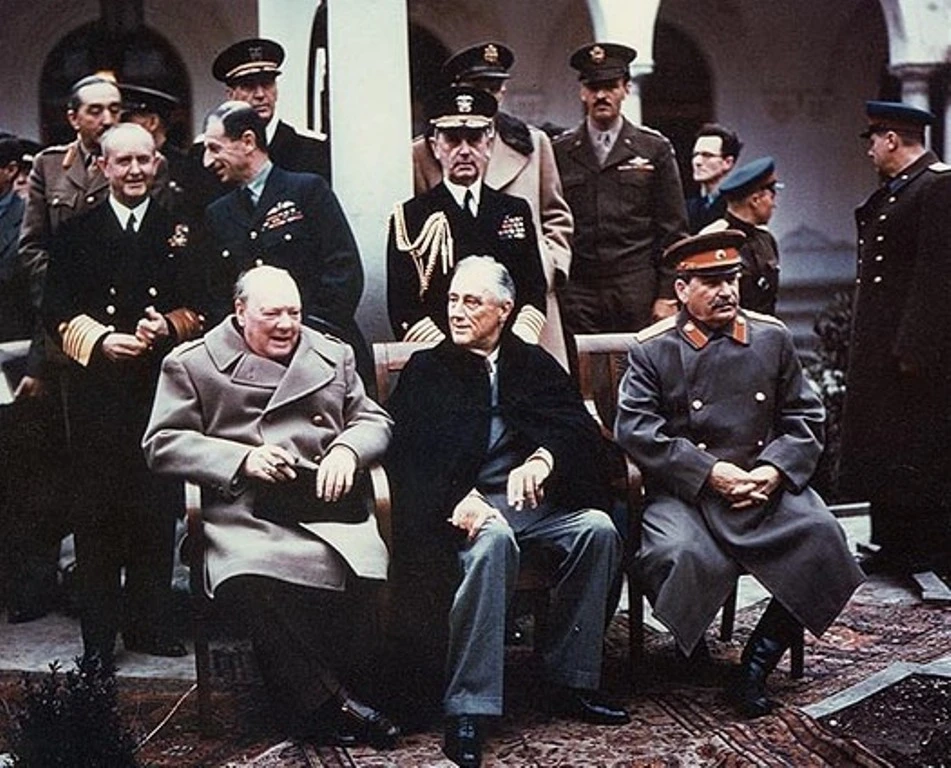
Photo: Wikipedia
According to the terms of the agreement, the Soviet Union was to enter the war no later than three months after its victory over Germany. On the last day, this did happen. On August 8, the USSR declared war on Japan, and on August 9, it launched its offensive. Despite the fact that on August 6 and 9, the Americans dropped nuclear bombs on Hiroshima and Nagasaki, which became the generally accepted determining factor in the end of the war.
Thus, by September 2, 1945, when the Japanese signed the surrender, the Soviet Union had fully occupied the entire Kuril archipelago. In 1947, the Russians created a separate Sakhalin Oblast, which included the Kuriles. In the following years, the Japanese were evicted and replaced by immigrants from other regions of the USSR.
But at the official level, the war between the USSR and Japan continued. After all, the Soviet Union did not sign the San Francisco Peace Treaty of 1951, which was supposed to legalize all the nuances associated with Japan's defeat. The document did not enshrine the USSR's rights over the Kuriles and South Sakhalin (by the way, as well as China's territorial right to Taiwan).
“Japan relinquishes all rights, title and claim to the Kuril Islands and to that part of Sakhalin Island and the adjacent islands over which Japan acquired sovereignty under the Treaty of Portsmouth of September 5, 1905,” the document read.
However, it was not clearly stated which islands and what was actually considered the Kuril Islands. Because for the Japanese, the southern Kuriles were not part of the Kuril Islands, and this became an issue that is still being debated.
Until 1956, the Russians and the Japanese were officially at war. Only the Joint Soviet-Japanese Declaration of 1956 put an end to this, allowing for the exchange of embassies and trade, but not resolving the main issue, the disputed territorial question.
The Japanese have insisted and still insist that they claim a group of four southern Kuril Islands - Habomai, Shikotan, Kunashir and Iturup - which is the original line that was approved in 1855. Japan included them in Hokkaido Prefecture. However, the Russians did not agree to this, offering at most the small islands of Habomai and Shikotan, and then after the Japanese finally agreed that they would not demand anything else.
The position of the United States also played an important role. After all, in the 1950s, the Americans told the Japanese that if they signed the agreement, as the Soviet Union wanted, the United States would not return the Ryukyu archipelago and the island of Okinawa, which the United States occupied during the war, to Tokyo.
As a result, both sides of the conflict failed to resolve the territorial issue, which was postponed until a major peace treaty was signed. But this did not happen. In the 70 years since that Moscow declaration, no peace treaty has been signed, and all the Kuril Islands remain part of the Russian Federation, which Tokyo does not recognize.
Although the area of the disputed islands is only 5,000 square kilometers, the total area of the disputed territory, including the 200-mile economic zone, is approximately 200,000 square kilometers (one third of Ukraine's area).
Why the dispute over Japan's Northern Territories is in Ukraine's favor
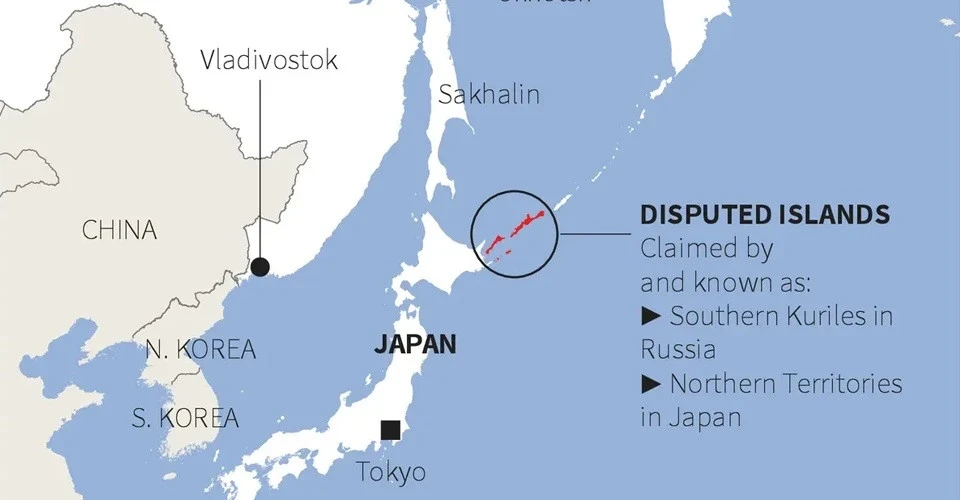
Photo: Wikipedia
After USSR collapsed, there were repeated attempts to find a solution to this issue. But all of them failed because the Russians were not ready to make territorial concessions, and the Japanese were not ready to give up their territorial claims. Today, Russia classically claims that its sovereignty over the southern Kuril Islands is “absolutely legitimate and not subject to doubt or discussion,” and for decades has said that it does not recognize the very existence of a territorial dispute with Japan.
Instead, Japan has been celebrating the Northern Territories (Southern Kuriles) Day on February 7 every year since 1981, in honor of the 1855 Treaty of Shimoda, which Tokyo insists on returning. Actually, in Japanese terms, these four islands are: Habomai, Shikotan, Kunashir, and Iturup are not Kuril Islands, they are called the Chishim Islands and are considered Japanese. Moreover, the Japanese consider it incorrect to call these southern islands the Kuriles.
“Japan does not consider its Northern Territories to be part of the Kuril Islands, which is the main reason why Japan can claim these four islands. For Japan, the Northern Territories and the Kuril Islands (we call them the Chishim Islands) are different. ... When Ukrainians inertially use the Russian version of “Kuril Islands” as a synonym for the Northern Territories of Japan, it is perceived by the Japanese as incorrect,” Takashi Hirano, editor of the Japanese-language version of the Ukrinform website, explained in 2022.
In the early 2000s, when Vladimir Putin came to power, he tried several times to “sell” the 1956 Moscow Treaty to the Japanese again, i.e., to give away the two small islands of Habomai and Shikotan, while keeping the other two larger islands of Kunashir and Iturup for the Russians. But Tokyo was categorically against it.
At the diplomatic level, until 2003, Japanese diplomacy officially referred to the islands as “illegally occupied,” and until 2012 as “ancestral lands.” Since 2012, the government has avoided such language, hoping to reach a compromise with Russia. Moreover, a number of economic initiatives have been introduced to jointly develop the islands.
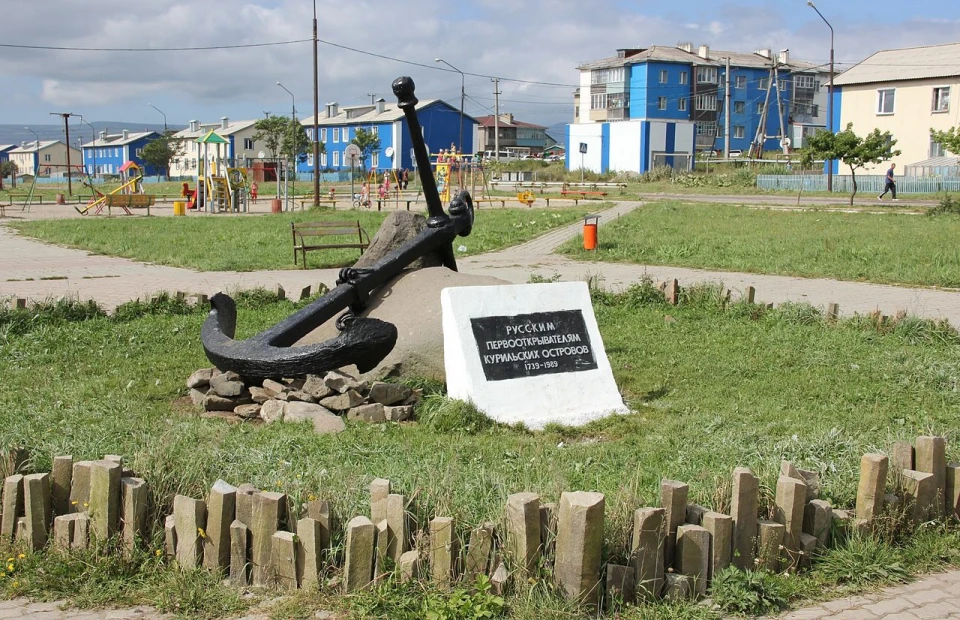
Photo: Wikipedia
However, the situation began to change in 2014, when Russia illegally occupied Ukrainian Crimea and launched a hybrid war in eastern Ukraine. After some hesitation, Tokyo declared that it would not recognize the annexation of Crimea, and in 2015, the Japanese prime minister paid his first official visit to Kyiv, imposed sanctions on Russia and spoke in favor of Ukraine's territorial integrity. Thus, he complicated the task of dialoguing with Moscow over the Kuriles. And Russia's full-scale war against Ukraine opened a new chapter in this confrontation.
After all, Tokyo joined the rest of the democratic world in condemning the actions of the Russians, imposing powerful new sanctions, and providing economic assistance to Kyiv. In addition, the Japanese have even changed their pacifist traditions to send some military equipment to the United States to replace the equipment that the Americans directly provide to Kyiv. And since the end of March 2022, Japan has once again begun to refer to the southern Kuril Islands as “Japan's ancestral territory under illegal occupation.” In October 2022, the Verkhovna Rada and the President of Ukraine also officially recognized the Southern Kuril Islands as the territory of Japan occupied by the Russian Federation.
As a result, Russia expectedly suspended all negotiations on a peace treaty with Japan and suspended economic activity and visa-free travel to the islands for Japanese citizens. This has become a problem for southern Japanese residents who live just a few tens of kilometers from the islands, which are still held by Russia.
Recently, the situation has become even more acute when the Kremlin banned non-Russian ships from sailing in the waters near the Kuril Islands. As James D.J. Brown, a professor of political science at Japan's Temple University, told Voice of America, Moscow is “continuing to take revenge on Japan.”
“The Putin regime believes it must take revenge for what it perceives as Japan's unfriendly actions. Every time Tokyo does something to help Ukraine or strengthen military ties with the United States, Moscow takes steps to punish Japan.”
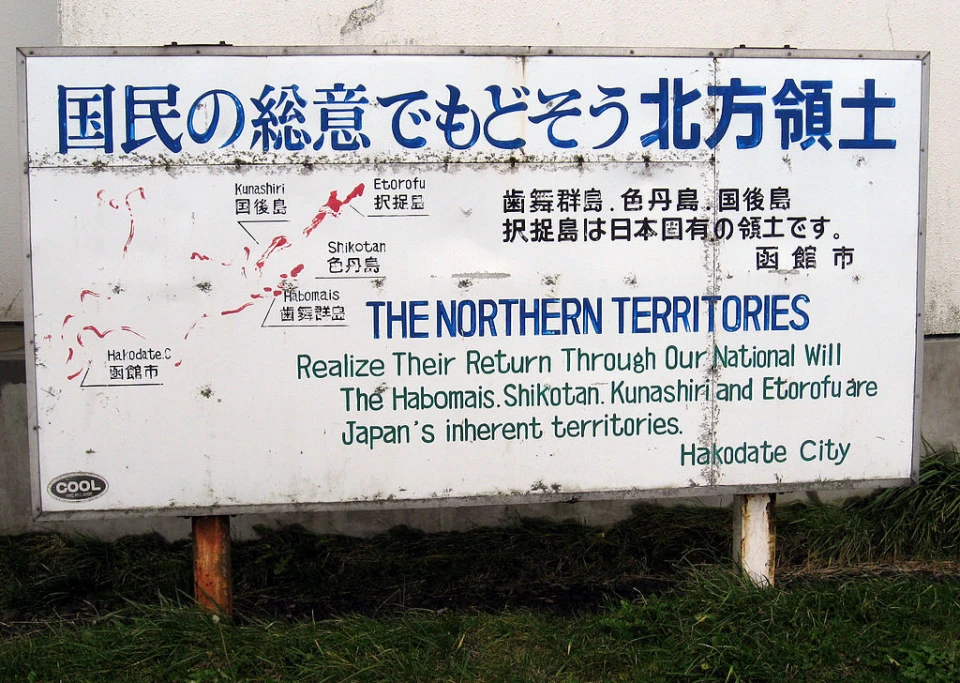
Photo: Wikipedia
However, there is currently no question of the possible use of military force. First, Japan has been pursuing a pacifist policy since World War II and until 2007 did not even have a Ministry of Defense, and the Japanese armed forces are still called the Self-Defense Forces. And, secondly, Russia itself does not have sufficient military forces in the Far East to wage another war.
Thus, the Japanese are gradually increasing defense spending, which is more than 1% of GDP (about $80-100 billion per year), which allows them to be among the top 10 armies in the world. However, Tokyo, remembering the lessons of World War II, will not be able to convince its population, let alone the world community, of the need for a military solution. Therefore, the Japanese government has opted for waiting, preparing for possible provocations by Russia and upgrading its troops, in particular, starting to manufacture its own attack drones. In any case, Ukraine's victory in the war with Russia is beneficial to Tokyo. After all, it will weaken Russia's position in the international arena and allow the Japanese to try to achieve their territorial claims, especially if Putin's imperial regime is overcome.
Nowadays, diplomatic circles are talking more and more about the possibility of signing a 10-year security agreement between Kyiv and Tokyo, which would be of undoubted benefit to Ukraine. After all, Japan is one of the most developed countries in the world, which can help Kyiv, if not with weapons, then with finance, its technology, and new sanctions.
“In the near future, a fairly strong and powerful bilateral security agreement with Japan will be concluded, several rounds of negotiations have already been held,” Deputy Head of the Presidential Office Ihor Zhovkva said in March.
In conclusion, there is an interesting historical parallel: Japan has always legitimized its territorial claims during wars it lost to Russia, as it did during the Crimean War and the Russo-Japanese War. It is possible that history will repeat itself after Russia's defeat in the current war with Ukraine. Then we can expect that Moscow will finally agree to recognize the southern Kuril Islands (or the Northern Territories) as part of the Japanese state.
- News











































